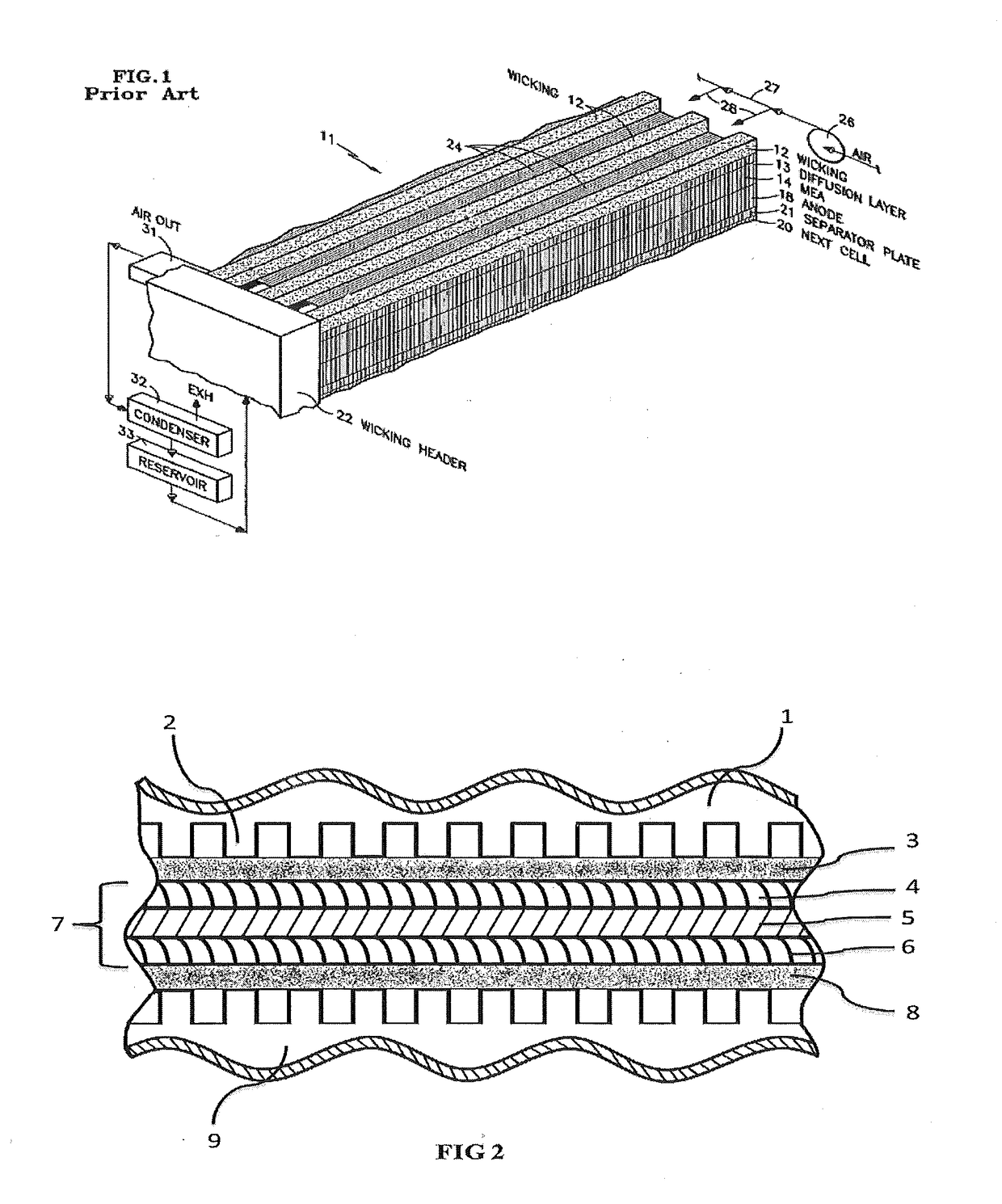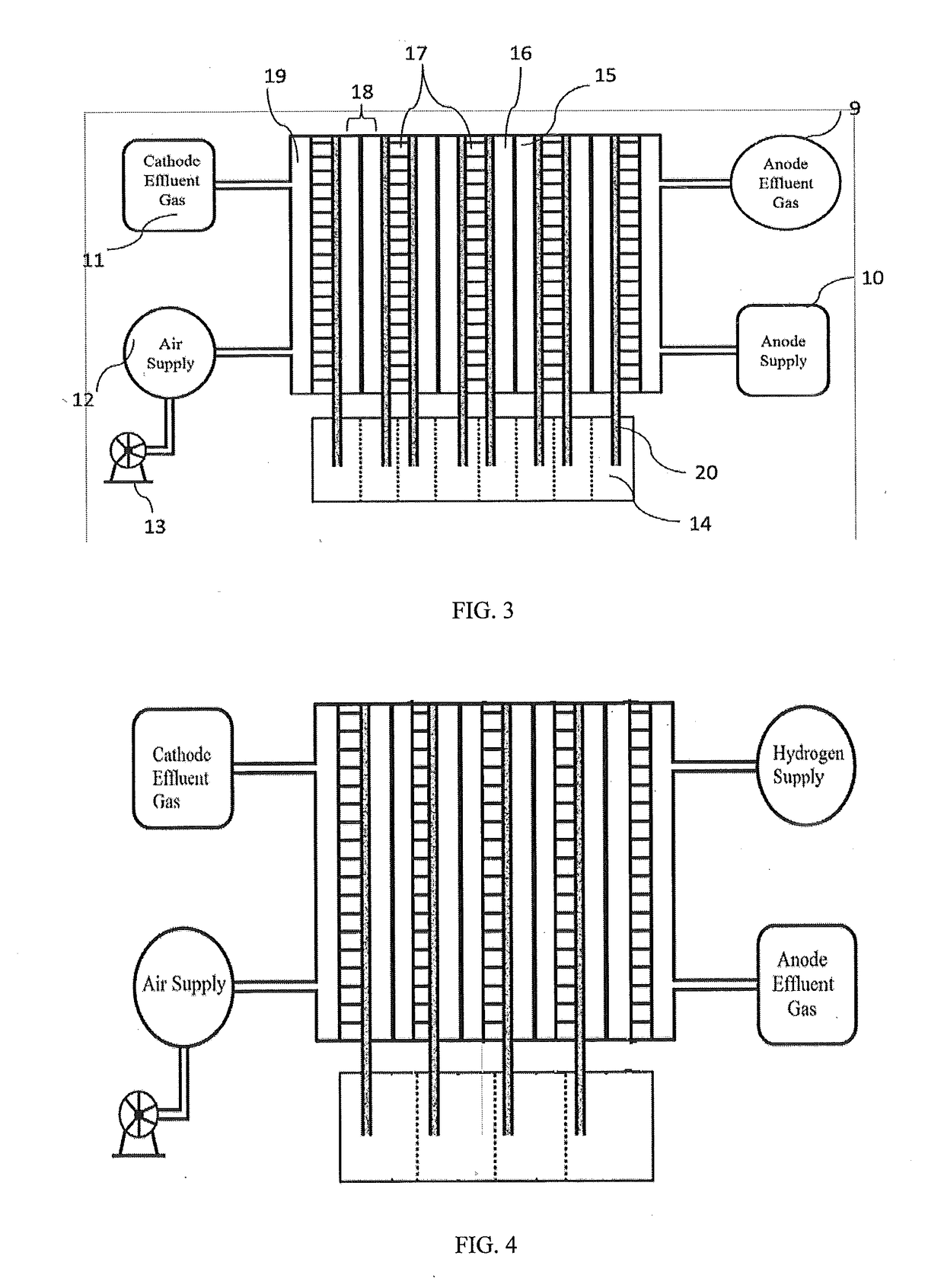Internal humidification in low temperature PEM fuel cell by means of a wick
a proton exchange membrane and fuel cell technology, applied in the field of new fuel cells, can solve the problems of adding to the parasitic power loss, adding to the system complexity, and humidifying gas, and achieve the effect of reducing the net parasitic load
- Summary
- Abstract
- Description
- Claims
- Application Information
AI Technical Summary
Benefits of technology
Problems solved by technology
Method used
Image
Examples
example 1
Measurement of Material Parameters Useful for Wicking Action and Thermal Stability:
[0058]Pore size distribution, gas permeability and contact angle play an important role for wicking action to take place in a porous hydrophilic material. It also gives an idea about the possibility of flooding of electrodes due to excess wicking. In order for wick to supply water to the fuel streams internally, it is essential that a positive wicking velocity be continuously maintained. Hence, optimum pore size distribution and permeability are critical for flood-free cell performance. Wicking action is in turn determined by using two important factors namely differential capillary pressure and wicking velocity. Differential capillary pressure (dPcap) is a function of surface tension of water, contact angle and pore diameter, whereas wicking velocity depends on the difference between dPcap and differential flow field pressure (dPflowfield), permeability, viscosity of fluid and channel length. Average...
example 2
Description of Experimental Configurations (A-D)
[0061]
TABLE 1Configu-Configu-Configu-Configu-ration Aration Bration Cration DPlacement ofNo wickOver anodeOver cathodeOver anodewickand cathodeExternalNoYesYesYeswater supplyto wickFlow mode atCounterCounter / CounterCounter / anodeCo-flowCo-flowFlow mode atCounterCounterCounter / Counter / cathodeCo-flowCo-flowMeans ofBubbleThroughBubbleThroughhumidificationhumidifierwickhumidifierwickat anodeMeans ofBubbleBubbleThroughThroughhumidificationhumidifierhumidifierwickwickat cathodeFeed at anodeHumidifiedDryHumidifiedDryFeed at cathodeHumidifiedHumidifiedDryDryInlet fuel50-5228-3050-5228-30temperature(° C.)Inlet oxidant45-4745-4728-3028-30temperature(° C.)
example 3
Control Experiment for Fuel Cell Performance (Configuration-A)
[0062]Configuration-A corresponding to the control single cell setup with external humidification of gases was taken as the base line performance for comparison with other configurations which make use of wick for internal humidification. The cell was supplied with 80% RH at the anode and 50% RH at the cathode. The humidification levels were maintained by controlling the humidifier temperature and gas line temperature. The gas line temperature was maintained at 60° C. for both anode and cathode. The humidifier temperature was maintained at 50° C. for anode and 45° C. for cathode. Galvanostatic polarization curve was recorded after cell stabilization for 6-8 h. The stoichiometry used for all tests was 1.2 for anode and 3 for cathode.
PUM
| Property | Measurement | Unit |
|---|---|---|
| thickness | aaaaa | aaaaa |
| pore size | aaaaa | aaaaa |
| contact angle | aaaaa | aaaaa |
Abstract
Description
Claims
Application Information
 Login to View More
Login to View More - R&D
- Intellectual Property
- Life Sciences
- Materials
- Tech Scout
- Unparalleled Data Quality
- Higher Quality Content
- 60% Fewer Hallucinations
Browse by: Latest US Patents, China's latest patents, Technical Efficacy Thesaurus, Application Domain, Technology Topic, Popular Technical Reports.
© 2025 PatSnap. All rights reserved.Legal|Privacy policy|Modern Slavery Act Transparency Statement|Sitemap|About US| Contact US: help@patsnap.com



